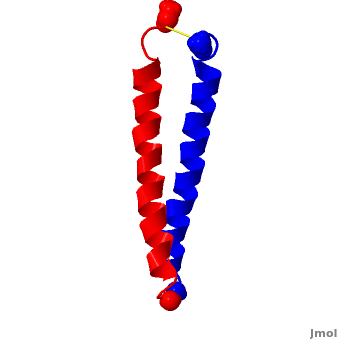C-Myc
From Proteopedia
|
Contents |
Overview
The c-Myc oncogene encodes a transcription factor, c-Myc protein, which is involved in the regulation of the cell cycle. C-Myc belongs to the Myc family of proteins including B-Myc, L-Myc, N-Myc, and s-Myc. c-Myc is a b-HLH-LZ (basic helix-loop-helix-leucine zipper) protein that must form a heterodimer with another b-HLH-LZ protein, Max, in order to bind DNA and activate transcription. Mutations in myc proteins or overexpression of their encoding genes have been linked to several forms of cancer, among these are lymphoma, myeloma, liver, lung, and breast cancer.
C-myc Bonding
The c-myc protein cannot homodimerize without the protein Max. Max can sometimes heterodimerize with Mad family proteins. The Mad-Max, Mad3-Max, Mad4-Max, and Mnt-Max heterodimers are antagonist of c-myc. The myc-max connection is unstable which allows for high populations of dissociated monomers and it impedes reassortment dictated by the level of expression of c-myc, mad, and mxi1 genes and transduction of cell growth and differentiation signals. For oncogenic activity to occur c-myc must bind with the Max protein. All max proteins will bind to the same DNA sequence.
General Functions of C-myc
C-myc is used in cell cycle entry, proliferation, and differentiation. C-myc also helps to bind DNA which activates transcription. The c-myc lives a very short life. It is controlled by the level and temporal pattern of expression of their corresponding gene. Without C-myc an organism is unable to survive since there is nothing allowing cells to differentiate or proliferate. The organisms cannot survive after the pre-T-cell receptor proliferation is unable to be completed.
C-myc is also involved in the bodies system of remebering past diseases. T-cells help the body to remember diseases it has previously had. C-myc controls the regulation of T-cells. Without C-myc the T-cells would not be triggered to multiply when a disease that the body has seen before infiltrates the body again.
C-myc's Role in Cancer
C-myc's proliferation is induced by enhancers that help to increase immunoglobin genes functions. It has been seen that the greater amount of C-myc present the higher the chances that cancer is also present. Cancer is often able to grow best in people with weakened immune systems. Since the immune system is weak the T-cells pass over the cancer without noticing that anything is wrong. This combined with the fact that these enhancers cause C-myc to rapidly produce cells is causing cancer in a body that cannot fight it off. The newly formed cells continue to grow on eachother. This causes a tumor that is cancerous that is unnoticed. The most common form of cancer that c-myc plays a role in is Burkitt's Lymphoma.
C-myc can not be induced by enhancers unless it has translocated from its normal spot on chromosome 8 to another chromosome. When C-myc is translocated to a spot next to a gene that is an immunoglobin enhancer gene it can eventually become a tumor. The reason for this is that when these genes code for the body to make more B-cells, they inadvertantly turn on the gene adjacent to them as well. Since C-myc is now the new gene next to the enhancer gene it starts to create alot of C-myc RNA and it then becomes C-myc transcription factor. The factor then induces cells to divide very rapidly. The cells then keep dividing until they have formed a cancerous tumor. This process shows that one cell is all that is needed to create a tumor.
References
Dang, C.V.(1999) c-Myc Target Genes Involved in Cell Growth, Apoptosis, and Metabolism. Molecular and Cellular Biology, 19: 1-11.
Nair & Burley (2003) X-Ray Structures of Myc-Max and Mad-Max Recognizing DNA: Molecular Bases of Regulation by Proto-Oncogenic Transcription Factors. Cell, 112:193-205.
Ohtsuki, Nishitani, Hatamochi, Yawata, & Namba (1991) Analysis of methylation in the c-Myc gene in five human myeloma cell lines. British Journal of Haematology. 77: 172-179.
Takahashi et al., (2007) Induction of Pluripotent Stem Cells from Adult Human Fibroblasts by Defined Factors. Cell. 131: 1-12.
Kaji, Norrby, Paca, Mileikovsky, Mohseni, & Woltjen (2009) Virus-free induction of pluripotency and subsequent excision of reprogramming factors. Nature. 458: 771-776.
Gardner, Lee, & Dang (2002) The c-Myc Oncogenic Transcription Factor. [1]
Dose et al., (2006) C-Myc mediates pre-TCR-induced proliferation but not developmental progression. Blood. 108: 2669-2677.
Proteopedia Page Contributors and Editors (what is this?)
Michal Harel, Hillary Sigale, Kim Smith, David Canner, Joel L. Sussman, Alexander Berchansky

